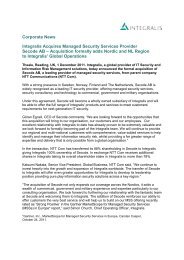to download PDF - Integralis
to download PDF - Integralis
to download PDF - Integralis
You also want an ePaper? Increase the reach of your titles
YUMPU automatically turns print PDFs into web optimized ePapers that Google loves.
3 Details in accordance with § 292a,<br />
subsection II No. 4b HGB<br />
The following significant differences exist between the consolidated<br />
financial statements prepared according <strong>to</strong> IFRS and the individual<br />
financial statements prepared according <strong>to</strong> HGB.<br />
3.1 Foreign currency translation<br />
The individual balance sheets of the consolidated companies show<br />
monetary positions in foreign currency in accordance with IAS 21 at<br />
the rate valid on the effective balance sheet date, whilst under HGB,<br />
the “Imparitätsprinzip” is applied. This results in non-realised foreign<br />
exchange gains.<br />
3.2 Deferred taxes<br />
The “Temporary” balance sheet-based concept is applied. According<br />
<strong>to</strong> this concept, the period over which timing differences may be<br />
recognised as deferred tax assets or liabilities is defined more widely<br />
under IAS 12 (rev 1996) than HGB. In addition, in contrast <strong>to</strong> HGB,<br />
tax claims on losses carried forward must be recognised as deferred<br />
tax assets, provided that future realisation of such assets is<br />
considered probable.<br />
3.3 Finance leasing<br />
The regulations for the capitalisation of leased assets deviate<br />
between IFRS and HGB. According <strong>to</strong> IAS 17, assets acquired under<br />
finance lease arrangements are capitalised on the balance sheet and<br />
depreciated, whilst those under HGB are usually capitalised by the<br />
lessor.<br />
3.4 Derivative financial instruments<br />
Under IAS 39, all derivative instruments are measured at fair value<br />
and recognised on the balance sheet. Changes in the fair value of<br />
derivatives that do not meet the criteria for hedge accounting are<br />
recognised in the income statement. Under HGB, unrealised losses<br />
on derivatives are recognised in the income statement while<br />
unrealised gains are not recognised in the financial statements.<br />
26<br />
4. Notes <strong>to</strong> the Consolidated<br />
Balance Sheet<br />
4.1 Accounts receivable and other assets<br />
Trade accounts receivable are shown net of allowances for doubtful<br />
receivables. Accounts receivable and other assets are receivable<br />
within one year.<br />
4.2 Inven<strong>to</strong>ries<br />
Inven<strong>to</strong>ries are sub-divided as follows:<br />
31.12.2002 31.12.2001<br />
€ k € k<br />
Finished goods<br />
Less: provision for slow moving<br />
5,066 9,959<br />
and obsolete inven<strong>to</strong>ries -506 -196<br />
Total inven<strong>to</strong>ries 4,560 9,763<br />
4.3 Fixed assets<br />
Changes in the book value of fixed assets are disclosed in the fixed<br />
asset movement schedule (see Appendix <strong>to</strong> the Notes). During the<br />
year the Group carried out a fair value review of the goodwill arising<br />
from its investments and other fixed assets resulting in the<br />
recognition of an impairment loss <strong>to</strong>talling €19,226k in the profit and<br />
loss account.<br />
4.4 Financial assets<br />
Financial assets are analysed as follows:<br />
31.12.2002 31.12.2001<br />
€ k € k<br />
Equity securities 5,147 5,117<br />
Provision for impairment -2,229 -2,229<br />
Fair Value 2,918 2,888<br />
A provision for impairment was made in full against the Telenisus<br />
investment in 2001.





